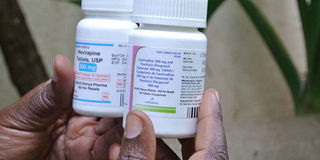WHO raises alarm over resistance to HIV drugs

This picture taken on June 17, 2015 shows antiretroviral drugs that are used to treat HIV-infected people. The increasing HIV drug resistance trend could lead to more infections and deaths. PHOTO | SARAH OOKO
What you need to know:
- The agency warns that this growing threat could undermine global progress in treating and preventing HIV infection.
- HIV drug resistance develops when people do not adhere to a prescribed treatment plan.
The World Health Organization (WHO) has raised the alarm over an increasing trend of resistance to HIV drugs.
The agency warns that this growing threat could undermine global progress in treating and preventing HIV infection if early and effective action is not taken.
TREATMENT
Observing an increasing trend of resistance to HIV drugs, the WHO last week issued fresh guidelines to tackle the threat in a report based on national surveys conducted in several countries.
The WHO HIV Drug Resistance Report 2017 shows that in six of the 11 countries surveyed in Africa, Asia and Latin America, over 10 per cent of people starting antiretroviral therapy (ART) had a strain of HIV that was resistant to some of the most widely used medicines.
INFECTIONS
The increasing HIV drug resistance trend could lead to more infections and deaths.
“We need to proactively address the rising levels of resistance to HIV drugs if we are to achieve the global target of ending Aids by 2030,” Dr Tedros Adhanom Ghebreyesus, the WHO director-general, said.
COSTS
Mathematical modelling shows an additional 135,000 deaths and 105,000 new infections could follow in the next five years if no action is taken, and HIV treatment costs could increase by an additional Sh67 billion during this period.
ART is treatment of people infected with the human immunodeficiency virus using anti-HIV drugs.
The standard treatment consists of a combination of at least three drugs that suppress the replication of the virus.
PRESCRIPTION
WHO recommends that countries that have reached the 10 per cent threshold should urgently review their HIV treatment programmes.
HIV drug resistance develops when people do not adhere to a prescribed treatment plan, often because they do not have consistent access to quality HIV treatment and care.
PATIENTS
WHO says in severe cases, the patient will require to move to either the second or third line treatment regimens, which are three times and 18 times more expensive, respectively, than first line drugs.
Patients with HIV drug resistance will start to fail therapy and may also transmit drug-resistant viruses to others.
The level of HIV in their blood will increase, unless they change to a different treatment regimen, which could be more expensive — and, in many countries, still harder to obtain.
RESISTANCE
In Kenya, studies show that there has been increasing cases of drug resistance.
For instance, at least one in 10 people in Homa Bay County who is HIV-positive has a strain that is resistant to at least one of the available antiretrovirals, even when he or she has never been put on any HIV/Aids treatment, a research study shows.
TRANSMISSION
These are people infected by types of HIV that are resistant to at least one of the currently available antiretroviral (ARV) drugs, according to the study report, published in the journal PloS One early this year.
This transmitted drug-resistant (TDR) strain is passed on in the same ways as ‘normal HIV’.
UNSAFE SEX
They include having unprotected sex with an HIV-positive partner who has TDR, sharing contaminated needles or blades, from a mother with TDR to her child, or through transfusion of infected blood.
“Our study shows that for every 100 of the recorded new infections in rural western Kenya, about nine have strains of HIV-1 already resistant to the ARV regimens.
"But, from what we observed, 9.2 per cent was moderate as per the World Health Organization’s TDR surveillance classification scale,” Mr Harris Onywera, the lead author of the report published in Plos One, said.
PREVALENCE
The Nation interviewed the lead author when the report was released in March.
Homa Bay County has a HIV prevalence rate of 26 per cent, the highest in the country, with at least 400 children getting infected every day.
Currently, it costs the government Sh20,000 annually to put one HIV patient on treatment.
There are over 1.6 million Kenyans living with the virus and about one million on treatment.
PROBLEM
Of these, it is not clear how many have TDR HIV.
“At the moment, our results show that the TDR level in rural western Kenya is relatively higher than for most regions (including urban settings).
"We suggest that the survey be repeated in order to confirm these findings, to further understand the scale of the problem and access the potential sources of HIV drug resistance,” Mr Onywera said.





